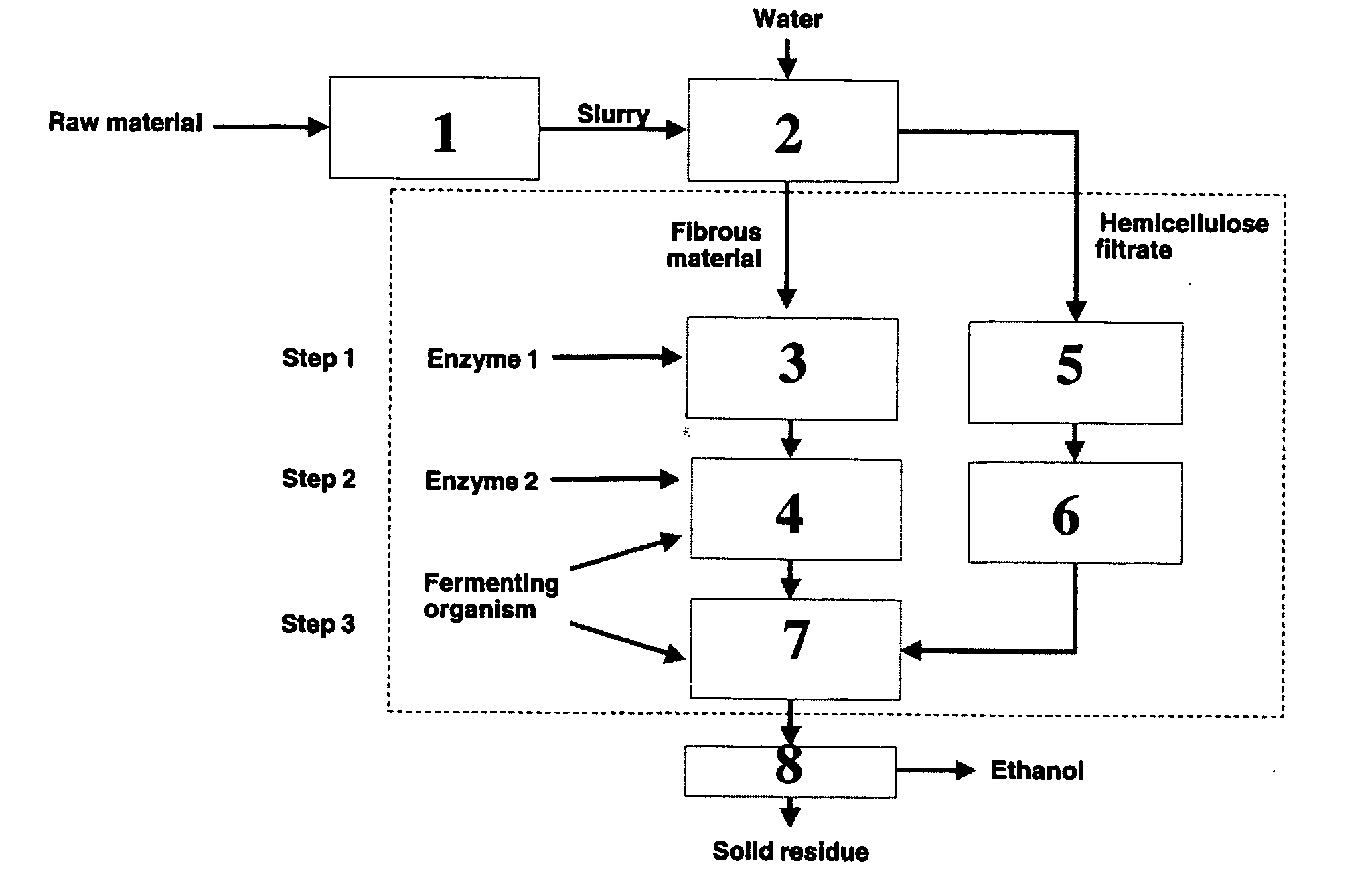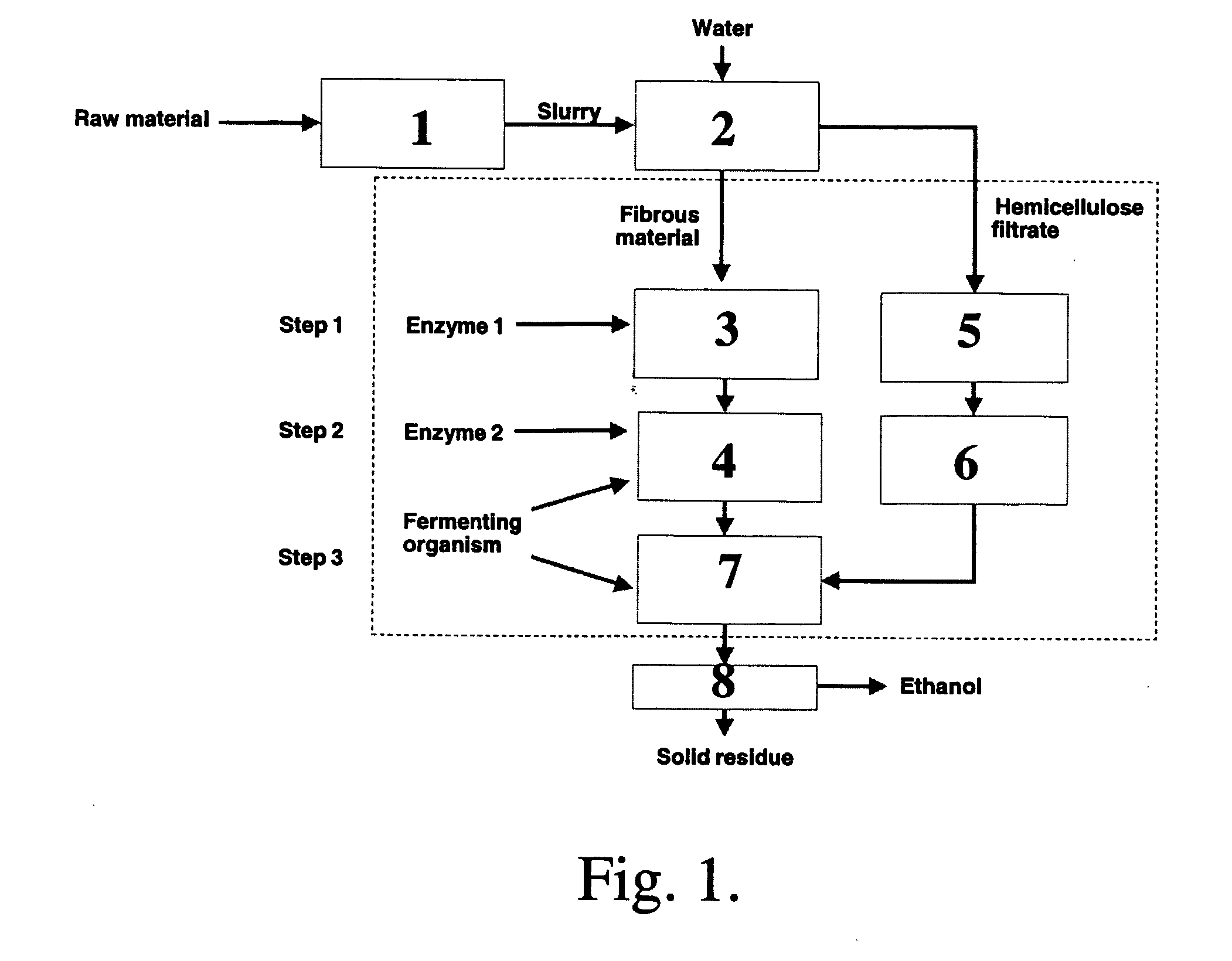Process for Producing Ethanol
a technology of ethanol and process, which is applied in the field of ethanol production, can solve the problems of low concentration and yield of ethanol, high cost of lignocellulose conversion technology, and high cost of lignocellulose containing raw materials, so as to improve production rate and yield, improve economic and efficiency, and increase the final ethanol concentration
- Summary
- Abstract
- Description
- Claims
- Application Information
AI Technical Summary
Benefits of technology
Problems solved by technology
Method used
Image
Examples
example 1
Pre-Hydrolysis of Pretreated Softwood
[0067] Softwood was steam pretreated and divided into two fractions; a solid fraction containing mainly cellulose and a soluble fraction containing mainly the hemicellulose sugars and the inhibitory compounds. The solid fraction was filtrated, washed and suspended to form a fibre suspension with dry matter of 14.4%. The fibre was pre-hydrolyzed using commercial enzyme preparations (Celluclast 1.5 L FG, 20 FPU / g d.w. and Novozym 188, beta-glucosidase dosage 200 nkat / g d.w) at 50° C. for 2 to 20 hours.
[0068] During the hydrolysis 74% of the cellulose of fibre was hydrolysed to glucose that was present in the liquid fraction in the concentration of 46 g / l. In addition, the liquid part contained small amounts of other fermentable sugars: 0.1 g / 1 mannose, 0.03 g / l galactose and 0.04 g / l xylose. The viscosity of the solid fraction was decreased rapidly during the hydrolysis and the mixing properties were clearly improved already within 2 first hours ...
example 2
Ethanol Production from Prehydrolysed Softwood
[0071] Softwood was steam pretreated and divided into two fractions; a solid fraction containing mainly cellulose and a soluble fraction containing mainly the hemicellulose sugars. The solid fraction was filtrated, washed and suspended to form a fibre suspension with dry matter of 14.5%. The fibre was pre-hydrolyzed using commercial enzyme preparations at 50° C. The hydrolysis conditions were: 13.3% solids d.w. in acetate buffer, pH 5, the enzyme preparations used were Celluclast 1.5 L FG, 20 FPU / g d.w. and Novozym 188, with beta-glucosidase dosage 200 nkat / g d.w. After 20 hours, the prehydrolyzate was tempered to 30° C. and inoculated with the yeast (strain VTT-B-03339) suspended with nutrients before inoculation in 10 vol-% (of the pre-hydrolysate) to water. The reference treatment was carried out under the same conditions, but the yeast was inocculated in the beginning of the process immediately after the addition of the enzymes.
[00...
example 3
Ethanol Production from Pre-Hydrolysed Softwood With and Without the Hemicellulose Fraction
[0073] Softwood was steam pre-treated and divided into two fractions; a solid fraction containing mainly cellulose, and a soluble fraction containing mainly the hemicellulose sugars. The solid fraction was filtrated, washed and suspended to form a fibre suspension with dry matter of 18%. The fibre was pre-hydrolyzed using commercial enzyme preparations at 50° C. The hydrolysis conditions were: 16.2% solids d.w. in acetate buffer, pH 5, the enzyme preparations used were Celluclast 1.5 L FG, 20 FPU / g d.w. and Novozym 188, with beta-glucosidase dosage 200 nkat / g d.w. After pre-hydrolysis ca. 20% of the cellulose in fibre fraction had been hydrolysed to glucose.
[0074] After 20 hours, the prehydrolyzate was tempered to 30° C. and inoculated with the yeast (strain VTT-B-03339) suspended before inoculation with nutrients in ca. 10 vol-% (of the pre-hydrolysate) to water.
[0075] The hemicellulose fi...
PUM
| Property | Measurement | Unit |
|---|---|---|
| temperature | aaaaa | aaaaa |
| temperatures | aaaaa | aaaaa |
| temperature | aaaaa | aaaaa |
Abstract
Description
Claims
Application Information
 Login to View More
Login to View More - R&D
- Intellectual Property
- Life Sciences
- Materials
- Tech Scout
- Unparalleled Data Quality
- Higher Quality Content
- 60% Fewer Hallucinations
Browse by: Latest US Patents, China's latest patents, Technical Efficacy Thesaurus, Application Domain, Technology Topic, Popular Technical Reports.
© 2025 PatSnap. All rights reserved.Legal|Privacy policy|Modern Slavery Act Transparency Statement|Sitemap|About US| Contact US: help@patsnap.com


